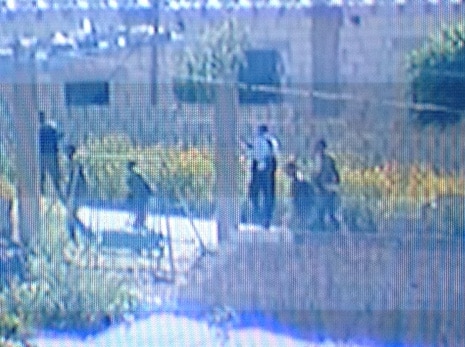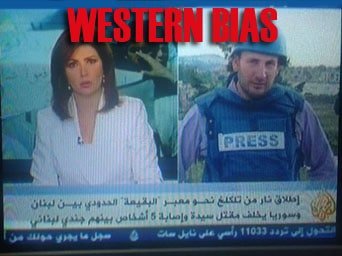 Al Jazeera’s Shaping of the Syrian Story
Al Jazeera’s Shaping of the Syrian Story
by Sharmine Narwani
Of all the myths obstructing the honest portrayal of events in Syria this past year, none has been more fiercely guarded by regime-change advocates than this one stark falsehood:
Myth – the Syrian regime has only been shooting unarmed, peaceful protestors until very recently when opposition groups finally decided to arm themselves in self-defense.
On the contrary, there is clear evidence that armed groups have targeted and killed security forces and civilians from within weeks of the first small protests in March 2011. An earlier investigative piece I wrote on the Syrian casualty lists identifies the shooting deaths of nine Syrian soldiers in Banyas on April 10, 2011 as one important timeline marker for premeditated opposition violence.
Ignoring this vital piece of information about the security landscape has helped shape a fundamentally flawed narrative of events in Syria. Furthermore, this false storyline has directly contributed to the escalation of the crisis by inciting rage against the “one-sided” violence of the regime, and emboldening opponents with a misplaced “righteousness” that kills legitimate debate on Syria.
But this narrative has been unraveling in the past few months. Photos and video footage of armed men with heavy weapons proudly declaring their stripes – some of them religious extremists advocating the killing of civilians based on sectarian differences – have been recently making the rounds.
Jihadist web chatter about armed groups in Syria, suicide bombings in Damascus and Aleppo, and now Al Qaeda’s “call to battle” have forced western pundits – who know a red line when they see one – to grudgingly acknowledge there are two sides in Syria’s violent tug of war.
Quite suddenly, this has forced a shift in the discourse on Syria. Regime opponents have taken care, however, to ensure that the new narrative incorporates the existence of armed groups without challenging the core premise that “the regime massacres peaceful protestors.”
This effectively means that armed opposition can only be introduced into the Syrian crisis “timeline” at a date long after the outbreak of protests.
Consequently, it is only in early 2012 that references to armed militias have trickled into the media marketplace – and always in the context of a carefully scripted storyline which misleadingly claims – as in this February New York Times opinion piece: “the resistance” has only “now begun to arm itself and to exercise self-defense.”
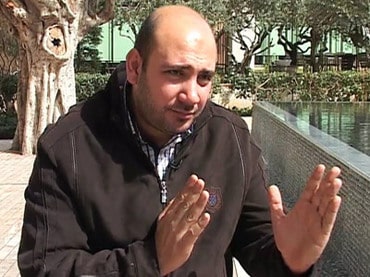
Al Jazeera’s Shaping of the Syrian Story
Ali Hashem’s resignation from Al Jazeera last month may not have raised an eyebrow in normal circumstances.
But the Beirut-based correspondent was one of a number of Al Jazeera employees whose hacked-and-leaked emails displayed a growing dissatisfaction with their satellite network’s biased coverage of Syria.
His exit from the troubled media company is eclipsed, however, by the bombshell he is about to drop.
Hashem claims Al Jazeera refused to air footage of dozens of armed gunmen engaging with targets inside Syrian territory in May 2011. He and his crew, Hashem reports, also witnessed armed groups entering Syria three weeks earlier, in April 2011, but were only able to capture them on film in May. Some of the weapons they sighted included Kalashnikovs and Rocket Propelled Grenades (RPGs).
But now Hashem reveals that he has in hand the actual censored video footage of opposition gunmen engaged in clashes in Syria last May and that it will be broadcast later this week.
During a brief preview of the footage on his iPad in a Beirut cafe, the veteran journalist explains: “I have both the footage which Al Jazeera refused to air and footage of the segment that was broadcast. On air, I am telling viewers that I am witnessing armed men clashing with the Syrian army, though what you read on Al Jazeera’s screen says something entirely different. This is in the Talkalakh area on the Syrian-Lebanese border, on the Syrian side. You can see the militants shooting in the video. And when you do a comparison of the two videos, you can see they are in the same place.”
Below is a still shot from Hashem’s exclusive footage showing gunmen operating inside Syria in May 2011:
The value of the newsworthy footage was not lost on Hashem and his crew, so he was surprised when Al Jazeera’s then-acting head of news told him via phone “ensa enno fee masallaheen” or “forget there are armed men.”
Hashem refused, and a heated defense of professional reporting ethics ensued until he was assured that he could speak freely on the air. He did – but Al Jazeera did not broadcast the accompanying footage of gunmen while Hashem was on air describing them. The network later insisted that it was a genuine “mistake.”
It will be interesting to see if Hashem’s footage actually changes the dominant view on Syria. There is little incentive for the mainstream media to self-correct a narrative that feeds into a lucrative formula: bad dictator, peaceful protestors, regime change, happy ending.
In fact, it is quite galling to see how complicit the various media outlets, human rights groups, governments and major NGOs continue to be actively supporting a false version of events.
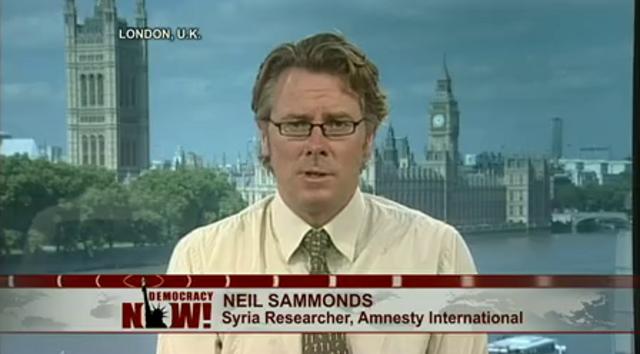 The killing of the nine Syrian soldiers in Banyas last April, for instance, was whitewashed by Al Jazeera, The Guardian, BBC and other news outlets who quote “activists” saying the nine were executed by fellow soldiers for refusing to fire on civilians.
The killing of the nine Syrian soldiers in Banyas last April, for instance, was whitewashed by Al Jazeera, The Guardian, BBC and other news outlets who quote “activists” saying the nine were executed by fellow soldiers for refusing to fire on civilians.
But YouTube searches for some of the dead soldiers – Lieutenant Colonel Yasar Qash’ur and Colonel Waeb Issa – shows actively pro-regime funerals, and not the kind of memorial services reserved for opposition sympathizers.
Human rights groups have been even more shameless in underplaying violence by armed opposition groups. Amnesty International’s Syria Researcher Neil Sammonds, on a recent BBC radio interview, famously invokes a “black eye” as one example of armed opposition abuses – as though he genuinely could not recall any significant reports of violence associated with these gunmen. It is a pity for him then that I have in hand the lengthy correspondence between Sammonds and a Syrian activist that details opposition killings, torture and violence – the activist imploring him over and over again to investigate these crimes and highlight their prevalence inside Syria.
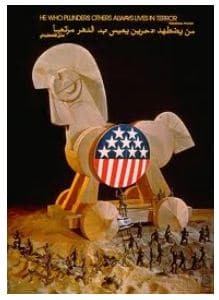
An unexpected press release by Human Rights Watch on March 20 does exactly that. It is the first rights group to highlight opposition violence to this extent, but predictably does so within the old timeline narrative, placing armed groups into the Syrian storyline well after protests kicked off in March 2011. The HRW briefing specifies:
“The protest movement in Syria was overwhelmingly peaceful until September 2011. Since then, an increasing number of media and other reports have said that a growing number of military defectors and local residents have decided to resort to arms, saying they are defending themselves against security forces’ raids or attacking checkpoints and security facilities in their cities.”
I had a chat with HRW researcher Ole Solvang about the discrepancy in these conflicting timelines – and he openly admits: “The key is in the word ‘overwhelmingly.’ We don’t mean to say that there were no violence against government forces before this. What we mean is that anti-government violence became more organized and frequent after this.”
In fact Solvag concedes that there isn’t much that HRW can conclusively state about opposition violence in the early stages of the protest movement. “We have documented that there has been violence used against government forces before September….and against captured soldiers and civilians.” Solvag cautions that this “does not justify the government opening fire on protestors,” and then surprises me with the admission, “even if there were sometimes weapons in the crowds and some demonstrators opened fire against government forces.”
Here’s why I think Ali Hashem’s video footage needs an airing. It is time for a wholesale reevaluation of the facts in the Syrian crisis – beginning on day one, from the ground up, without any of the old assumptions that inhibit investigation outside of the bad-guy-good-guy theme. Maybe there aren’t any good guys in Syria? Or maybe the crisis in Syria is less about Syrians than it is about the geopolitical aspirations of others? We will only know this more decisively if we scroll back to Hashem’s April 2011 timeline to find out who hijacked the peaceful protests in Syria. Was it the regime – or the regime-changers? Unless we trace this back to the beginning, any step forward will be proceeding deaf, dumb and blind in Syria.
Original source: Alakhbar English
Sharmine Narwani is a commentary writer and political analyst covering the Middle East. You can follow Sharmine on twitter @snarwani.
Editing: Debbie Menon
Al Jazeera exodus: Channel losing staff over ‘bias’
Al Jazeera journalists quit channel citing bias on Syria coverage
ATTENTION READERS
We See The World From All Sides and Want YOU To Be Fully InformedIn fact, intentional disinformation is a disgraceful scourge in media today. So to assuage any possible errant incorrect information posted herein, we strongly encourage you to seek corroboration from other non-VT sources before forming an educated opinion.
About VT - Policies & Disclosures - Comment Policy

